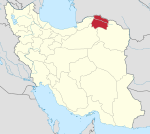Khan Laq, North Khorasan
Khan Laq (Persian: خانلق) is a city in the Central District of Shirvan County, North Khorasan province, Iran.
Demographics
Population
At the time of the 2006 National Census, Khan Laq's population was 4,905 in 1,138 households, when it was a village in Ziarat Rural District. The following census in 2011 counted 7,714 people in 2,064 households. The 2016 census measured the population of the village as 6,518 people in 1,912 households. It was the most populous village in its rural district.
After the census, Khan Laq was elevated to the status of a city.
See also
Notes
References
- ^ OpenStreetMap contributors (28 October 2024). "Khan Laq, Shirvan County" (Map). OpenStreetMap (in Persian). Retrieved 28 October 2024.
- ^ Census of the Islamic Republic of Iran, 1395 (2016): North Khorasan Province. amar.org.ir (Report) (in Persian). The Statistical Center of Iran. Archived from the original (Excel) on 27 October 2020. Retrieved 19 December 2022.
- ^ Khan Laq can be found at GEOnet Names Server, at this link, by opening the Advanced Search box, entering "-3070650" in the "Unique Feature Id" form, and clicking on "Search Database".
- ^ Jahangiri, Ishaq (26 September 2021) [Approved 5 May 1400]. Letter of approval regarding the conversion of Khan Laq village of Ziarat Rural District, Central District of Shirvan County, North Khorasan province, into a city. sdil.ac.ir (Report) (in Persian). Ministry of the Interior, Council of Ministers. Notification 47687/T58418H. Archived from the original on 28 March 2023. Retrieved 6 September 2024 – via Shahr Danesh Legal Research Institute.
- ^ Census of the Islamic Republic of Iran, 1385 (2006): North Khorasan Province. amar.org.ir (Report) (in Persian). The Statistical Center of Iran. Archived from the original (Excel) on 20 September 2011. Retrieved 25 September 2022.
- ^ Census of the Islamic Republic of Iran, 1390 (2011): North Khorasan Province. irandataportal.syr.edu (Report) (in Persian). The Statistical Center of Iran. Archived from the original (Excel) on 19 January 2023. Retrieved 19 December 2022 – via Iran Data Portal, Syracuse University.
